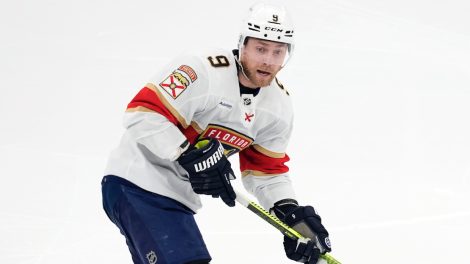Neither of the New York Islanders or Philadelphia Flyers have advanced beyond the second round in the past decade, so some team is breaking through in 2020.
Philadelphia remains the favourite, both as the top seed in the East out of the round robin and as one of the hottest teams prior to the pause. But the Islanders, for a second year in a row, have upset their way to the second round with an all-around team effort, strong defence, capable goaltending and excellent coaching. The Flyers may have more widely known names on their roster, but the Islanders are turning heads for other reasons.
Here’s how the two teams match up with one another:
ADVANCED STATS
Playoff 5-on-5 numbers via Natural Stat Trick
NY Islanders: 48.93 CF%, 75.00 GF%, 96.27 SV%, 9.28 SH%, 1.056 PDO
Philadelphia: 43.72 CF%, 66.67 GF%, 95.6 SV%, 9.30 SH%, 1.049 PDO
POST-SEASON TEAM STATS
NY Islanders: 15.8 PP%, 75.0 PK%, 30 GF, 21 GA
Philadelphia: 11.4 PP%, 82.8 PK%, 19 GF, 14 GA
REGULAR SEASON HEAD TO HEAD
NY Islanders: 2-0-0
Philadelphia: 0-1-1
[snippet id=4931344]
New York’s primary strength: Team defence and tenacity
It might not be the most exciting brand of hockey, but Barry Trotz’s system is darn effective. The Islanders’ special teams aren’t performing particularly well, they’re pretty average in the faceoff circle and even though they don’t have any full-fledged superstar players yet, this team just doesn’t go away.
You have to play the Islanders for a full 60 minutes as they tend to get stronger as the game goes on. They win 75 per cent of the games in which they give up the first goal, outscoring their opponents 11-4 in third periods.
Semyon Varlamov has benefitted from his team’s defensive prowess, posting an impressive .934 save percentage and 1.67 goals-against average. He hasn’t faced more than 29 shots in any post-season contest so far.
Philadelphia’s primary strength: Team depth and versatility
The top teams have the best mix of all styles from all ages, and the Flyers fit that to a tee. From veteran stars like Claude Giroux and Jakub Voracek, to emerging youngsters Travis Konecny and Joel Farabee, the Flyers’ forwards have offensive contributors from all ages. Down the middle, Philadelphia is big with a defensive lean, while the blue line is a combination of players of varying skill sets. In net, 22-year-old Carter Hart is the elite keeper the Flyers organization has been searching decades for.
At 5-on-5, the Flyers have outscored their competition by a 2:1 ratio in these playoffs, though most of that surplus was gained in the round robin. The Flyers were one of the hottest teams before the break, winning nine of their last 10 games, and have continued that success in the bubble. Perhaps their build-up is coming together now, though they still have to prove they can hang with the best in the playoffs and get through a tough defence, the likes of which they’ll see against New York.
New York’s primary weakness: Depth forwards not chipping in on offence
The way the Isles play, three goals is often all that’s required to pick up a W but a deep Cup run won’t be easy without more supplemental scoring. Yes, the top two lines are carrying the load – Anthony Beauvillier, Josh Bailey and Brock Nelson have been particularly great – but Jean-Gabriel Pageau’s line only contributed one goal against the Washington Capitals, which was five fewer than they had against the Florida Panthers in the qualifying round.
Philadelphia Flyers primary weakness: Power-play inefficiency
In the regular season, the Flyers’ 5-on-5 offence generated the seventh-most goals as their power play finished middle of the pack, but it’s taken a turn south in the playoffs. The Flyers’ 11.4 power-play success rate in the post-season so far is the worst of any remaining team, which is creating more pressure to produce at evens. Against the Montreal Canadiens, the Flyers only held a one-goal advantage at 5-on-5; a team with more goal scorers could have really put Philadelphia in a bind.
[snippet id=4167285]
NY Islanders X-Factor
Anders Lee is the leader of this team yet his production has not matched his ability thus far. He only has three points in the post-season, scoring in each of the first three games against the Capitals. For a player who is tied for 13th most goals in the NHL since 2016-17, more is expected of the Isles captain in the offensive zone. On the positive side, Lee is a big body who has bite to his game. He got under the skin of the Capitals and even dropped the gloves with Tom Wilson to answer for a big hit he threw on Nicklas Backstrom. That same energy, plus a few more points, will be a boon to his team in the conference semifinals.
Philadelphia Flyers X-Factor
A healthy scratch twice against Montreal, James van Riemsdyk is averaging just 11:31 of ice time per game, second-lowest on the team. But, if there’s one player who could help the power play in one short burst, it’s van Riemsdyk, who has historically been productive with the man advantage. He has yet to score or even record a point in these playoffs, so unlocking van Riemsdyk’s goal-scoring ability could be key for the Flyers against New York’s stingy defence when they’ll need all hands on deck.
[relatedlinks]









